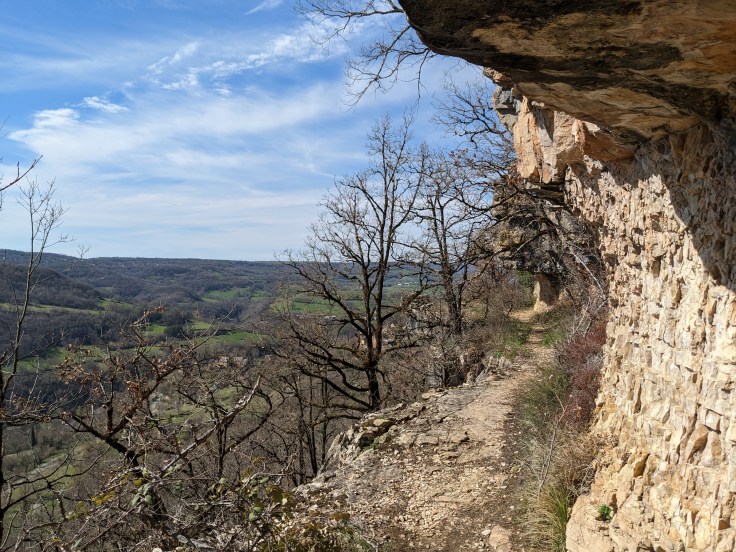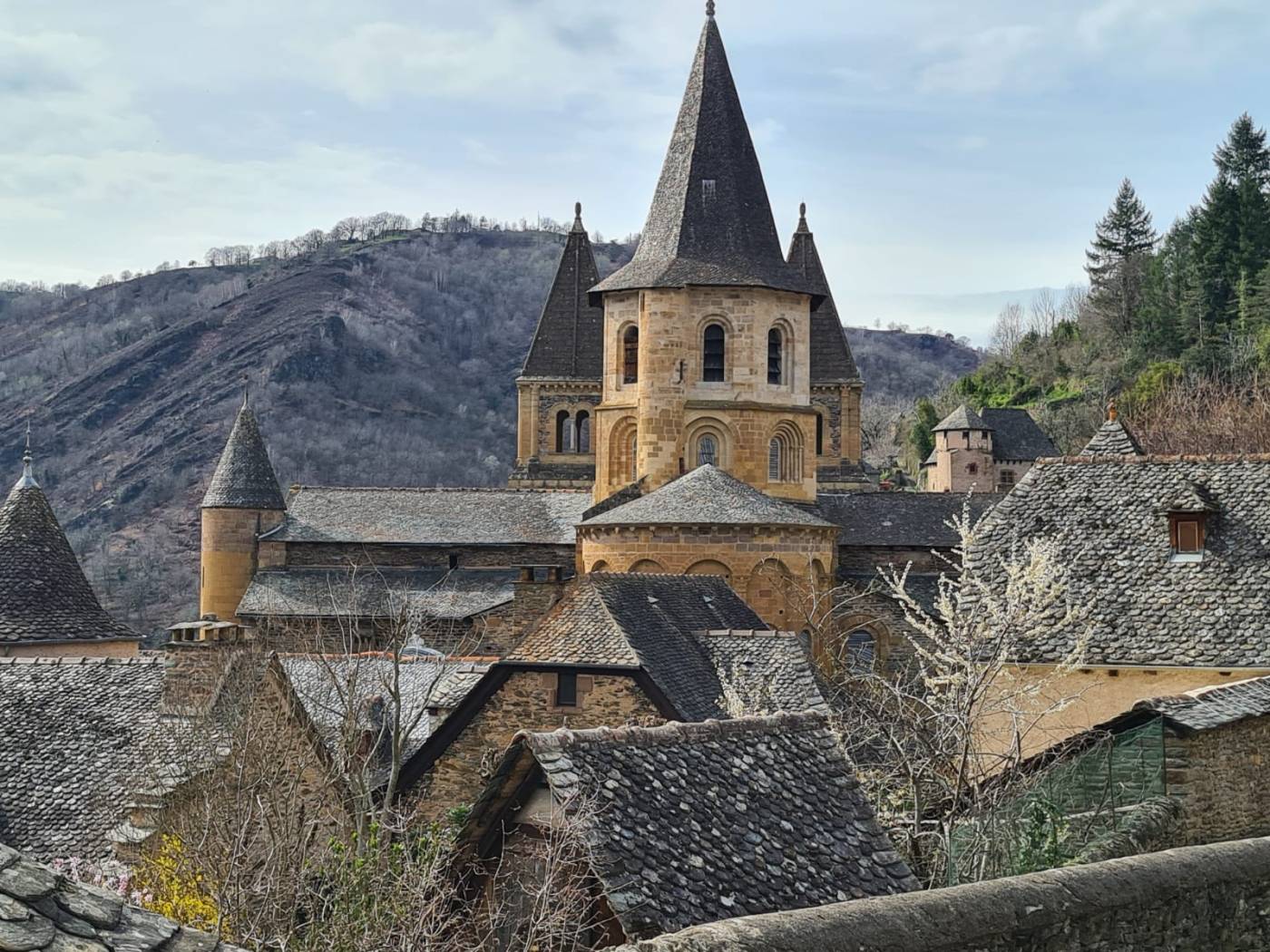Retreat in Aveyron

On a whim, I decided to take a few days off for a yoga retreat. Lugging a suitcase around Europe can sound luxurious until you actually are the one physically having to do it, and I didn’t mind a few days of zen. I chose a small 5-day retreat in the region of Aveyron, which to my mind was just a place on a map in the middle of nowhere. So, a good place to not feel pressured to explore and see everything I could for a few days. To my surprise and delight, Aveyron turned out to be a hidden, brilliant gem in the countryside of France with ample regional delights to discover.
It’s rather inconvenient to get to the region by train, although it is possible to catch one of the occasional slow trains to the city of Rodez. It was far easier just to rent a car, and although I am fast becoming loathe to drive across the French countryside (their amount of speed trap radars is proportionally insane and yes, I’ve been caught a few times), the drive itself was a jaw-dropping overture to the landscape of Aveyron.
The France I am used to is either rather flat with small occasional hills (see: outside Paris, Lyon, or the Corbières), or unapologetically mountainous and steep (see: the Alps). As I drove, what I took to be a flat landscape was in fact a large plateau, and suddenly the road plunged into deeply cut gorges with twists and turns and villages built into the cliffsides. The road occasionally brought me up for air onto more plateaus, and the views from the top made it clear that the gorges were completely disguised and you wouldn’t know they were there until you reached them. Or fell into them.
This is Aveyron – part plateau, where the famous cheese of Roquefort comes from, and part verdant gorges, peppered with medieval villages that are portals back in time.
Salles-La-Source
My yoga retreat was in the cliff-side village of Salles-la-Source. The village is broken up into three “quartiers”, or neighborhoods, based on their level on the cliff. Perhaps the most iconic image of the village is the powerful waterfall bursting out of the cliff in-between the second and third highest sections. The land here is quite calciferous, and there is a network of water tunnels spreading out like a spider’s web beneath your feet. Occasionally, those water tunnels find the open air through a cliff-side, and that results in multiple waterfalls spitting out the cliff sides.


The site of the retreat itself was La Source de Vallon, a hotel that used to be a watermill. Everyday the small group of us woke up for yoga at 8:30am, breakfast, a hike in the region, lunch and some free time, yin yoga at 5:30pm, dinner, and bed. All the food was vegan, and despite a fairly structured schedule it was nice to have the free time in the afternoons to explore the area, especially since it had so much to offer. Even the hikes were full of history, as we casually walked past old wine caves built into the upper cliffs, or an ancient “dolmen”, or megalithic tomb.
Conques
Conques was the site of a medieval abbey founded in the 11th century. From that abbey, a town grew up around it to support it. Driving up the steep hillside to get to the parking lot, I noticed numerous signs for parking and tour buses. The parking lot I found could accommodate hundreds and hundreds of cars, but I was only one of four cars parked. Not coming in the tourist season counts for a lot.

I stepped out of my car and into a historical fantasy. (To my fellow nerds- it was like a town from the Witcher 3 without any monsters. At least that wouldn’t come out in daylight…) It is picturesquely medieval with winding streets, timber-framed houses, slate roofs, maze-like pathways, and old stone steps. Many houses had little gardens just peeking forth the buds of spring, and several cats lazed on stones in the sun as they watched me walk by. Sadly, all of the shops were closed since the tourist season wouldn’t start for a few weeks, but I will say it’s nice to explore a town without masses of tourists or souvenir stands selling plastic swords and overpriced postcards. It’s easy enough to explore in just a few hours, and I saw the church, the abbey treasures, all of the streets, and the town perimeter in that time.
The abbey’s treasures – the treasures of Saint-Foy – are open to the public for a small fee. Since they are considered religious artifacts and still used for ceremonies today, no photos are allowed. I admit that I find myself less and less inclined to photograph the panoply of religious relics across Europe, so I didn’t mind. Christian treasures are all strikingly similar – dripping in gold and gemstones, with awkward pre-perspective faces and promises of saintly relics hidden within the brilliance. However, as I learn more and more of the history of the Dark Ages, and read more and more novels set in that time, the treasures are cast in a different light for me. People were poor, overworked, desperate, and rarely had anything of material beauty in their lives. Today we are used to our rose gold and sterling silver jewels, our shiny pots and pans, our bleached floors. The tarnished, gaudy treasures in a rural abbey may not speak to us. But imagine a lowly serf encountering these treasures. A richly-robed priest walking through a cavernous stone building, taller than you have ever seen. Jewels and filigree and the promise of salvation. It would be hard not to fall under the spell in those days. Now, it is the spell of the past that we meander through instead, just trying to imagine what they felt like as best we can.
Rodez

The city of Rodez is certainly more modern than Conques, though it still has quite a bit of history. (Who am I kidding, it’s France, so does every corner bakery). Founded in the 5th century by the Celts, Rodez is now the seat of government for the Aveyron region. It has several iconic buildings, such as the Maison d’Armagnac. The token cathedral was slightly different from others in that the main entrance isn’t directly opposite the apse and choir, but instead within the walls of one of the side aisles. This is because the cathedral was built into the town’s fortification wall – may as well make use of what’s there. Outside of the cathedral and the Musée des Beaux-Arts – which wasn’t much more than one room with an assortment of paintings and sculptures hard-pressed to be grouped into some kind of them – I wasn’t drawn to much in the city except the Musée Fenaille.
The Musée Fenaille is a museum housing one of the largest collections of “statue-menhirs” in Europe. Statue-menhirs are carved sculptures resembling menhirs (those tall, upright stones you imagine when you think of Stonehenge), set upright into the ground and depicting feminine or masculine characters. They are the oldest monumental statues in Europe, and date back to 5000 years ago. The museum is several stories high, and the self-guided tour starts at the top before you circle your way down through the millennia. (I do wonder why they designed it with the heaviest pieces of the exhibition on the top floor, but hey, design over convenience). As someone who is in awe of artifacts from the 16th century, coming face-to-face directly with artifacts carved by humans 5000 years ago was breathtaking. Just a few feet separates visitors with the statues, not even a pane of glass. They remain steeped in enigmas – what were they for? Archaeologists have given it their best guesses. Perhaps they represent heroes, or dignitaries? They were most often situated at ancient crossroads or smooth hillsides ideal for grazing. You can see depictions of necklaces on the women and daggers on the men. There were lots of other artifacts on display as well, including some Gallo-Roman dice that looked like they could have come out of a board game on my shelf. And there was a skeleton on display – a person who had died with shackles around their neck and arms over a thousand years ago. If that doesn’t make history real, I don’t know what would.


I’m not usually drawn to temporary exhibitions in museums, since they often house modern art completely incongruous with the history I just visited. However, on display at the museum was art by Olivier Douzou, full of adorable illustrations of the statue-menhirs come to life. It added a lot to the experience of what I just saw, and he even had carved an actual statue-menhir himself in his style. I appreciated seeing the awe-inspiring statues in such a jovial light.
A Taste of Aveyron
There’s no visiting a new region in France without trying out the local fare. It’s amazing to me that despite being only an hour or two from the next region over, a French region can have wildly distinctive cuisine that you would struggle to find anywhere else. I enjoyed a “gâteau à la broche”, which is a cake made by turning a spit in front of a fire and drizzling batter over it that cooks as you turn it, creating a distinctive conical shape. A shopkeeper also let me try some “flaune”, a dessert made from heating up the curds of sheep’s milk. I enjoyed it so much that I came back to her shop before I left the city and bought a whole piece to shamelessly eat on the drive home. (Driving and eating at the same time, how American!)




There was so much more that I did not try, as I didn’t have enough time to seek it out. Such as “aligot”, a melty mixture of mashed potatoes and cheese, or “fouace”, a traditional cake. Nor did I try “tripous”, made of calf stomach, ham stuffing, garlic, and parsley – but you know what, I will just let that fall onto my plate if I’m meant to try it, no need to seek it out.
Aveyron has the rugged and raw landscape of France I’ve been craving, as well as some rugged and raw traditions and people. As I get deeper and deeper into France, I am continuously delighted with the wildly unique regions presenting me with diverse history, culture, tradition, and last but never least, “gastronomie”.


Leave a comment